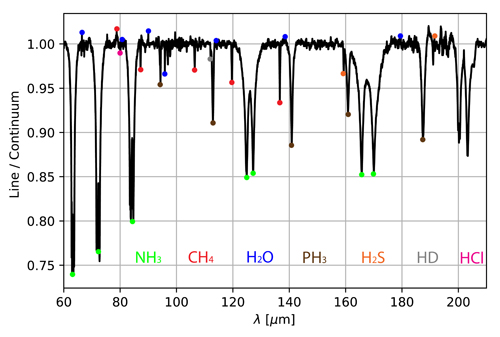Retrieval of Jupiter’s atmospheric parameters using far infrared spectra measured with PACS onboard the Herschel Space Observatory
- 1Max Planck Institut für Sonnensystemforschung, Justus-von-Liebig-Weg 3, 37077 Göttingen, Germany
- 2Faculty of Science, Kyoto Sangyo University, Motoyama, Kamigamo, Kita-ku, Kyoto, Kyoto 603-8555, Japan
- 3Max-Planck-Institut für Extraterrestrische Physik, 85748 Garching, Germany
- 4LESIA, Observatoire de Paris, PSL Research University, CNRS, Sorbonne Universités, UPMC University of Paris 06, Université Paris Diderot, Sorbonne Paris Cité, 92195, Meudon, France
On October 31, 2009, the Photodetector Array Camera and Spectrometer (PACS) onboard the Herschel Space Observatory observed far infrared (FIR) spectra of Jupiter in the wavelength range between 55 and 210 µm in the framework of the program ‘Water and Related Chemistry in the Solar System’ [Hartogh et al., 2009]. We aim at inferring the abundances of the trace constituents and the atmospheric temperature profile using these data, a line-by-line radiative transfer tool [Villanueva et al. 2018] and the least-squares fitting technique. Early model preparations and an earlier presentation of the preliminary spectra are given in Sagawa et al. [2010a,b]. Now, we present a more comprehensive data analysis. The spectra’s spectral resolution (R=λ/Δλ) depends on wavelength and grating order of the measurements and ranges from 990 to 5500. However, the effective spectral resolution was determined using detected, but unresolved spectral lines of stratospheric water, and varies between 1000 and 3000. Strong spectral features of methane (CH4), ammonia (NH3) and phosphine (PH3) are clearly visible in the data (see fig. 1). Features from other species, such as water, hydrogen deuteride (HD), hydrogen sulfide (H2S) and some hydrogen halides, such as hydrogen chloride (HCl), are also present in the data and might be used to retrieve upper limits for the relative abundances of these species. We assume a constant CH4 abundance due to vertical mixing and the lack of methane cloud condensation. Inferring atmospheric parameters from compositional measurements will not only help to characterize the atmosphere of Jupiter but will also contribute to a better understanding of a plethora of physicochemical processes in the atmosphere.

Figure 1: PACS spectrum of Jupiter, expressed in line-to-continuum ratios. Coloured dots indicate the signatures attributable to different molecules in the atmosphere.
References:
Hartogh, P., Lellouch, E., Crovisier, J., Banaszkiewicz, M., Bensch, F., Bergin, E. A., ... & Blommaert, J. (2009). Water and related chemistry in the solar system. A guaranteed time key programme for Herschel. Planetary and Space Science, 57(13), 1596-1606.
Sagawa, H., Hartogh, P., Rengel, M., de Lange, A., & Cavalié, T. (2010a). Preparation for the solar system observations with Herschel: Simulation of Jupiter observations with PACS. Planetary and Space Science, 58(13), 1692-1698.
Hideo Sagawa, P. Hartogh, E. Lellouch, H. Feuchtgruber, G. Orton, et al. (2010b) Far Infrared Spectra of Jupiter Observed with PACS Onboard Herschel. American Astronomical Society, DPS meeting #42, 11/31/2010, Pasadena, CA, United States.
Villanueva, G. L., Smith, M. D., Protopapa, S., Faggi, S., & Mandell, A. M. (2018). Planetary Spectrum Generator: An accurate online radiative transfer suite for atmospheres, comets, small bodies and exoplanets. Journal of Quantitative Spectroscopy and Radiative Transfer, 217, 86-104.
How to cite: Gapp, C., Rengel, M., Hartogh, P., Sagawa, H., Feuchtgruber, H., and Lellouch, E.: Retrieval of Jupiter’s atmospheric parameters using far infrared spectra measured with PACS onboard the Herschel Space Observatory, Europlanet Science Congress 2020, online, 21 Sep–9 Oct 2020, EPSC2020-152, https://doi.org/10.5194/epsc2020-152, 2020.

